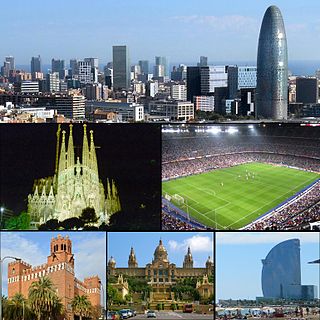
Montjuïc is a hill in Barcelona, Catalonia, Spain.

The former Hospital de la Santa Creu i Sant Pau in the neighborhood of El Guinardó, Barcelona, Catalonia, Spain, is a complex built between 1901 and 1930, designed by the Catalan modernisme architect Lluís Domènech i Montaner. Together with Palau de la Música Catalana, it is a UNESCO World Heritage Site.

The Gothic Quarter is the centre of the old city of Barcelona. It stretches from La Rambla to Via Laietana, and from the Mediterranean seafront to the Ronda de Sant Pere. It is a part of Ciutat Vella district.

The Forum Building, is an architectural landmark in Barcelona designed by the Swiss architects Jacques Herzog and Pierre de Meuron.

The Teatre Lliure is a theatre in Barcelona, Spain, considered one of the most prestigious in Catalonia.

Museu de la Xocolata is a private museum in Barcelona, Catalonia, Spain, owned by the Gremi de Pastisseria de Barcelona.
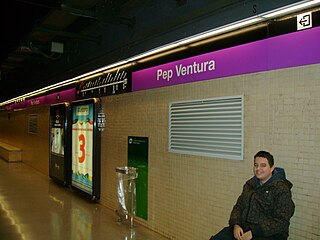
Pep Ventura is the name of a Barcelona metro station located in the municipality of Badalona, in the metropolitan area of Barcelona, and served by L2. It was the northern terminus of that line until 2010, when it was extended into the town centre and into the station Badalona Pompeu Fabra.
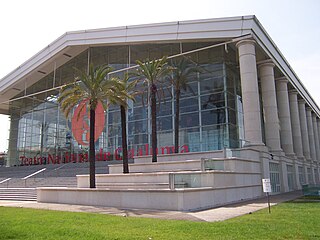
Teatre Nacional de Catalunya is a public theatre in Barcelona, Catalonia, Spain created by the Culture Department of the Catalan Government.

Palau Robert is a building on Barcelona's Passeig de Gràcia 107, the former private residence of Robert Robert i Surís, an influential aristocrat, politician and businessman at the turn of the 20th century. It's now a government-run institution that hosts an exhibition centre with three halls, a concert hall, and gardens as well as the Information Centre for Catalonia, including the city's tourism bureau. In the 1936-1939 period, it was the site of the Generalitat de Catalunya's Ministry of Culture. After the Spanish Civil War, Robert's family regained the Palau, until its second purchase by the Generalitat de Catalunya in 1981, when it became a public building.
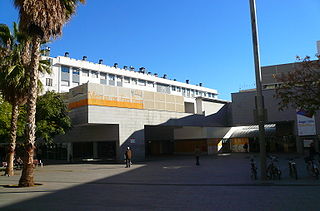
Fort Pienc is a neighborhood in the Eixample district of Barcelona, Catalonia, Spain. Its name stems from a former military fortification which existed there until the 19th century called Fort Pius, Pienc is an adjective in Catalan meaning related to the name Pius. There has been a strong Chinese presence in the area since the 2000s. The Arc de Triomf is the main attraction in the area, located in Passeig de Lluís Companys-Passeig de Sant Joan, while L'Auditori is an important concert hall. The National Theatre of Catalonia is another of its cultural centres, as is the General Archive of the Crown of Aragon, near Parc de l'Estació del Nord. The General Catalana de Electricidad building is a fine piece of modernisme or local art nouveau architecture. La Monumental is the only extant bullring in the city.

Sant Antoni is a neighborhood in the Eixample district of Barcelona, Catalonia (Spain). Its non-official centre, the marketplace of the same name—designed by Antoni Rovira i Trias and built between 1872 and 1882—is one of the oldest and most popular in the city, especially with the secondhand book stalls that surround the building Sunday mornings. It is bordered by the neighbourhoods of the L'Antiga Esquerra de l'Eixample, the Raval, and Poble Sec. The streets of Sant Antoni follow the grid pattern prevalent in all of Eixample, except for a central thoroughfare, the Avinguda de Mistral, built on the site of an important medieval road which led out of Barcelona. Another well-known landmark of Sant Antoni is the bar called Els Tres Tombs, right next to the market.

El Putget i Farró is a neighbourhood in the Sarrià-Sant Gervasi district of Barcelona, Catalonia (Spain), located on a hill between Vallcarca and Sant Gervasi, urbanised after the 1870s. It is formed by two quarters, the former neighborhoods of el Putget and el Farró.

Les Tres Torres is a residential neighbourhood in the inland Sarrià-Sant Gervasi district of Barcelona, Catalonia (Spain).

The Plaza Monumental de Barcelona, often known simply as La Monumental, is a bullring in the city of Barcelona, Catalonia, Spain. It was the last bullfighting arena in commercial operation in Catalonia. It was inaugurated in 1914 under the name Plaza de El Sport and was soon expanded and given its current name in 1916. It is situated at the confluence of the Gran Via and Carrer Marina in the Eixample district. It had a capacity of 19,582 within 26 rows of lines, boxes, and bleachers on the first floor inside and a superior barrage surrounding the building.

The Hotel Meliá Barcelona Sky is a skyscraper designed by Dominique Perrault located in Barcelona, Catalonia, Spain. The building is 116 metres (381 ft) tall and has 31 floors and 258 rooms. It is the fourth-tallest building in Barcelona after Torre Mapfre, Hotel Arts, and Torre Agbar.
The Museu Tèxtil i d'Indumentària, in English Textile and Clothing Museum, is a museum opened on 1982 and located in the Palau Reial de Pedralbes in Barcelona. The museum possesses countless objects and pieces of major artistic and historical value that make up their collections of garments, fabrics and jewellery. Regarding their collection of clothes, the museum allows you to take a journey through the history of textiles, from the 16th century right up to the modern day. The museum's collections include Coptic, Hispano-Arab, Gothic and Renaissance fabrics, as well as embroidery, a section on lacework and a collection of prints. Also worth mentioning is the jewelry collection, comprising approximately five hundred pieces that were made and produced in Spain.

Plaza de toros de las Arenas was a bullring in Barcelona, Catalonia, Spain. Over the years it featured numerous musical artists, including Carlos Santana and Paco de Lucia in 1977. It opened on June 29, 1900, and its last bullfight was held on June 19, 1977. The building was reopened in 2011 as a shopping mall named Arenas de Barcelona.

The Museu de la Música de Barcelona is a museum in Barcelona, Catalonia, Spain that houses a collection of musical instruments from around the world as well as biographical documents, from ancient civilisations to new technologies from the 21st century. The museum collection comprises 2000 musical instruments, 500 of which are on display, including one of the best guitar collections of the world. The museum covers historical, conservational and research aspects and promotes the city’s musical heritage.

Sant Llorenç del Munt is a Benedictine monastery in Matadepera, Vallès Occidental, Catalonia, Spain. It is situated on top of La Mola, the summit of the rocky mountain massif, Sant Llorenç del Munt, within Parc Natural de Sant Llorenç del Munt i l'Obac. It was declared a Bien de Interés Cultural landmark in 1931.
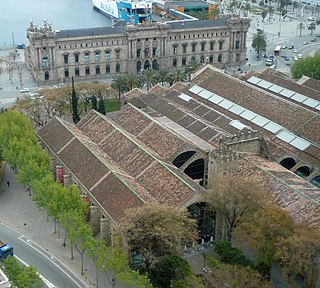
The Maritime Museum of Barcelona (MMB) is located in the building of Drassanes Reials de Barcelona , the royal arsenal of Barcelona, dedicated to shipbuilding between the thirteenth century and eighteenth century. The first mention of these arsenals date from 1243 in a document indicating the boundaries of the city of Barcelona where it mentions its shipyard.

